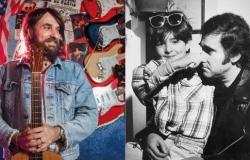The Arte Povera master Michelangelo Pistoletto is ninety years old and has the face and physique of Sean Connery. He is in a black suit, jacket with leather cuffs. For hours, he goes up and down the room trying to explain to me how art led him to discover the “Formula of Creation” also known as the “Third Paradise” and exhibited at the UN in Geneva and in Assisi, and why his Venus of rags calls the consciences of all of us by name. She walks, gets excited, talks about preventative peace and demopraxy and how all of us, together, can still save the world. He stops, blurts out: “It seems like I’m burdened by the universe, but of course: it’s all messed up.” The Pistoletto Foundation Città dell’arte Biella is populated by young people who follow courses ranging from Sustainable Fashion to Design and Art for Responsible Social Transformation. There are twenty-seven thousand square metres, where the master has carved out this dining room for himself with two of his mirrored paintings on the walls and a table cluttered with papers and then a small living room, kitchen and two monastic bedrooms. I ask him if this is where he creates and if he still creates objects as well as ideas. He: «In this house, there is no distinction between life and work». Finally, he sits down. He puts in front of me a green ceramic made of three small bowls attached: two on the sides, a larger one in the center. I ask: did she make it? “No”.
What purpose does it serve?
«Nothing. It follows the sign of the Third Paradise. I could put a liquid of one color here and another here which would pass to the center becoming a color that did not exist: it is a domestic instrument in which there is the formula of creation. Everything in the universe as in everyday life is given by the connection of two elements that create a third. Nature and human ingenuity create society by meeting. Hence, the theory of trinamics: one plus one equals three. Guido Tonelli, the discoverer of the Higgs Boson, also appreciated it.”
Give me an example adapted to everyday life.
«Any couple works like this. My wife of 57 years and I are the two people of the Third Paradise who, meeting here in the center, form a little big government. We don’t always agree, she has a very strong autonomy. I wake up at five in the morning, I write a little bit of the day to put into practice with her collaboration and the discussion between us generates something that wasn’t there before.”
How was the symbol born?
«I drew it in the sand crossing the infinity line twice. But it comes from mirror paintings, which welcome the infinite because everything that exists is reflected in it.”
Why did the first one have a shock while he was painting and had to stop working?
«I was refining a black background to make it shiny: in the brightness I was looking for my identity and the answers I asked myself as a child: who am I? Why do I exist? I was working on the self-portrait, but I would not have imagined that I would also see everything that was behind me appear, that is, the truth, since I was painted by myself and therefore I was not true, but what appeared behind me was true and this was total revelation. The mirror welcomes everything: space and time; mass and energy.”
And it welcomes those who look at it.
«I was looking for myself and I found “we”. I understood that no one can exclude others and that the meeting between you and I is the principle of society.”
Is there a politician who has done something concrete for the Third Paradise?
«A politician of politics in general? Ninth”.
What is demopraxy that he invented?
«The word was created by my son-in-law Paolo Naldini, who directs the Foundation, it stands for Demos, people, and praxis, practice. We try to achieve it by following a little yellow book where everything is written. Meanwhile, Biella has become a UNESCO Creative City and we have included 74 other Municipalities, creating the Archipelago City, in which the Third Paradise begins to come true because we have as much nature as artifice, there are fields, rice paddies, woods, there is nature that it becomes a city, it is not just the city that embellishes itself with nature as they do elsewhere. We bring together public and private organizations in working groups on topics such as clean energy or producing food without affecting the soil.”
What kind of child were you?
«At school, they told me that I had to believe in God and Mussolini, but at home I didn’t find support in these things. So, I was a child looking for something to believe in.”
First memory?
«The day in 1943 when my father opened the door of his painter’s studio in Turin and found the floor smashed by an unexploded bomb: if it had exploded, it would have killed all of us, crowded underneath, in the air raid shelter».
His first work?
«By chance, my mother enrolled me in Armando Testa’s graphic advertising course and, while attending it, I saw Lucio Fontana’s torn canvases for the first time. I thought: if an artist has the courage to produce things like this, she must have a motivation and if I find mine, I can be an artist too. I started with self-portraits because I wanted to get to know myself.”
The case is its theme. Was it really your fortune to hear, by chance, your gallery owner Mario Tazzoli speaking badly about you to Gianni Agnelli?
«When I made the mirror paintings, he didn’t understand them, but we had a contract and so he exhibited them. I heard him say to Agnelli: I’m ashamed, he’s gone crazy. I was shocked and ran away to Paris. We are in ’63, I go and Ileana Sonnabend, ex-wife of Leo Castelli, the New York gallery owner of Pop Art, sees one of my paintings, makes me a contract and I find myself exhibiting with Jasper Johns, Roy Lichtenstein and Andy Warhol. Chance was my ally, but I put my own spin on it: chance is a game in which you have to seize the opportunity.”
Why did you say goodbye to the big names of Pop Art within a year?
«Because, to be with them, I am asked to forget that I am European. And because Pop Art has the consumer system as its backdrop.”
Can you tell me about a discussion you had with Andy Warhol on the commodification of art?
«In your opinion, am I going to talk to Warhol who accepts being the brand of consumerism? In 1964, I brought artists, poets and musicians to the Zoo to fight imperialism in art and I made Less Objects: all different, with which no one could identify me. I then made the newspaper sphere that goes on the street and involves people. Everything I have done involves and activates people.”
Did your Venus of Rags really come from a dealer in garden statues?
«I saw it, I bought it, I brought it to my studio. I didn’t know what to do with it. There was a pile of rags and I told her: hold onto these.”
How do you explain that it has become so iconic?
“I do not know. People recognize in rags something they experience every day, their clothes, their most painful part, which is waste.”
Why did he only get married in 2017? And why Cuba?
«To have a practical mutual guarantee. We were in Havana for a UN Forum and it was the anniversary of our 50 years.”
What was the first meeting like?
«By chance, in a restaurant in Rome. The next day, I return to Turin and decide to take a train again to ask Maria to come with me.”
What had he seen in her?
«When something blooms, you shouldn’t let it slip away. I already had an ex-wife and a daughter. While we were going to Turin, I explained to Maria everything that would happen to her. It was the time of the Zoo and, that same evening, she found the group of poets at home, then the group of musicians. Then the twins arrived, we had more family life, but the whole family was involved in the Foundation.”
Have you ever thought about being a senator for life?
«No, and I don’t have time to go there. Here, I create what is not there. There, you have to be at the service of what is there.”
70 years after your first self-portrait, does the feeling of not knowing yourself remain?
«It remains, scaled down. Today, I know that I am the universe, but I don’t know what is beyond the universe.”
What would you like to be remembered for?
«They will remember me without thinking of me, because I will have produced things that in reality their children’s children will have done. But before saying goodbye, I have to read her a little something.”
What does the pizzino say?
«Immortal is not being, but knowing that you are».





